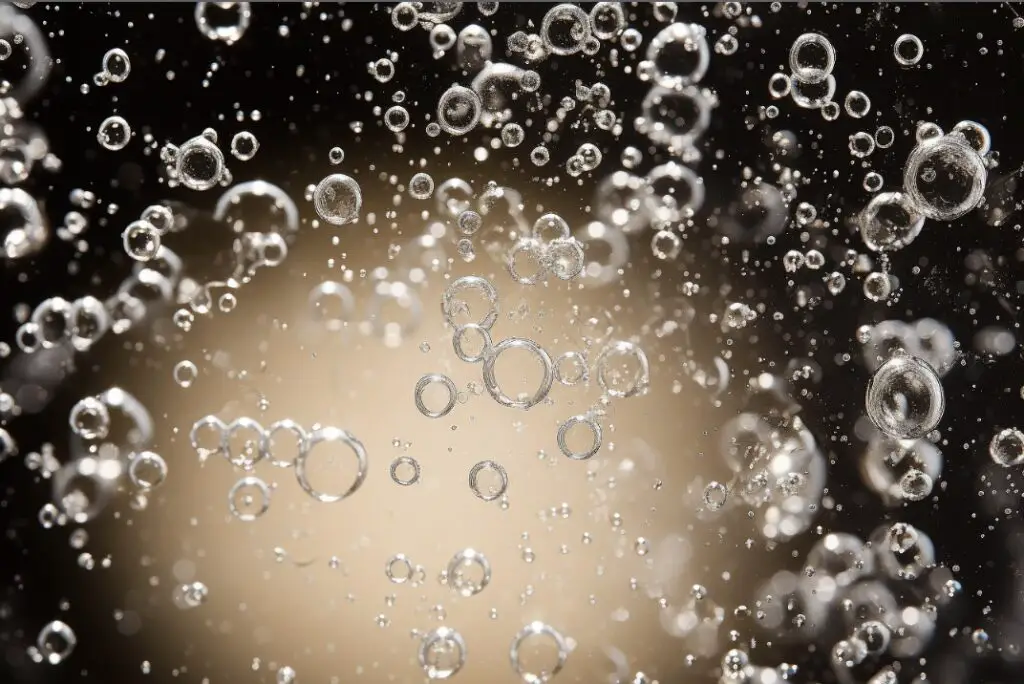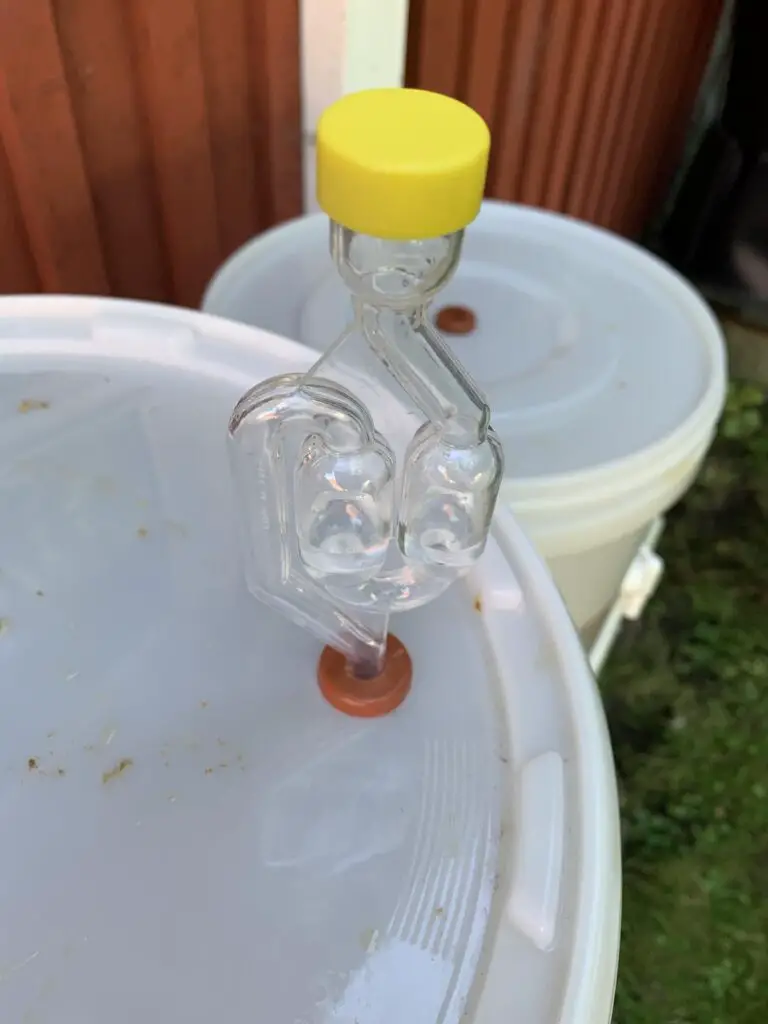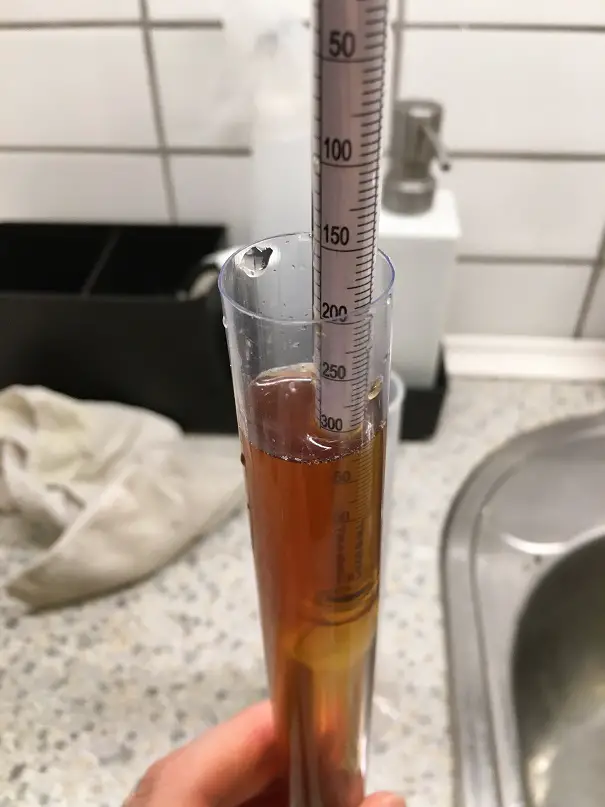If you’ve recently taken up homebrewing, one of the biggest questions you’ll likely have is, “how do I know if my homebrew is fermenting?”
This is a critical question because fermentation is the process that turns your mixture of water, malt, hops, and yeast into a delightful beer.
The main sign that a homebrew (whether it is beer, wine, cider or mead) is actively fermenting is the formation of CO2 bubbles in the liquid.
If an airlock is fitted on the fermenter, large bubbles will appear at reasonable short intervals (1 to 60seconds) if the brew is fermenting.
Other indications would be the gradual lowering of the sugar content (e.g. measured as SG or Brix) and the corresponding increase in alcohol.
As an experienced homebrewer, I’ve had my fair share of botched brews and successful suds. Let’s dive in and find out how you can tell if your homebrew is fermenting.
Understanding Fermentation
Fermentation is the process during which yeast consumes the sugars present in your wort (the sweet liquid extracted from malted barley) and produces alcohol, carbon dioxide, and heat. The production of alcohol is what turns your wort into beer or juice into wine or cider.

There are two stages of fermentation: primary and secondary. Primary fermentation is where most of the sugars are consumed and alcohol is produced. This process usually takes about one to two weeks. Secondary fermentation is more about flavor development and can take several weeks to months.
Signs of Fermentation
There are several signs that indicate your homebrew is fermenting. The most obvious is the formation of a foam layer, called krausen, on the surface of the wort. This is a sign that your yeast is active and consuming sugar.
The krausen can range in color from white to brown, depending on the type of beer you’re brewing.
Another sign of fermentation is airlock activity. The airlock is a device that allows gas to escape from the fermenter while preventing air and contaminants from entering. If your airlock is bubbling, that means CO2 is being produced, a clear sign of fermentation.

Finally, the specific gravity of your beer will drop as sugars are consumed and turned into alcohol. You can measure this with a hydrometer.
No Visible Signs of Fermentation
Sometimes, you might not see any visible signs of fermentation. This doesn’t necessarily mean your brew isn’t fermenting. Some yeasts work more quietly than others, and temperature can also affect the visibility of fermentation signs.
If there are no visible signs, your best bet is to use a hydrometer to measure the specific gravity.

If it’s dropping, and the fermenter is oxygen free, fermentation is happening.
Fermentation Temperature
The temperature at which you ferment your beer can significantly affect the fermentation process and the final taste of your beer.
Most ale yeasts perform best at temperatures between 68 and 72 degrees Fahrenheit, while lager yeasts prefer temperatures between 45 and 55 degrees.
Monitoring and controlling your fermentation temperature is essential for optimal fermentation and beer flavor.
Trouble Signs During Fermentation
While it’s great to know the signs of successful fermentation, it’s equally important to recognize the signs of a troubled fermentation process.
If your beer, cider or wine has a sour, rotten egg, or vinegar smell, it might be contaminated. Other signs of infection include a pellicle (a thin film on the surface of the beer), mold, or an unusually high final gravity reading.
If your fermentation is stuck, meaning the yeast has stopped working before all the sugar is consumed, your beer will taste overly sweet and have a lower than expected alcohol content.
Reviving a Stuck Fermentation
If you suspect your fermentation is stuck, don’t panic. There are a few things you can try to revive it. One option is to gently stir the beer to re-suspend the yeast. Another is to add more yeast.
You can also try raising the temperature a few degrees, as yeast activity can sometimes slow or stop at lower temperatures.
Remember, these are just solutions to try if you suspect stuck fermentation, but they aren’t guaranteed to work every time.
Conclusion
Fermentation is the heart of the brewing process, and knowing whether or not your homebrew is fermenting is crucial. Look for signs like krausen formation, airlock activity, and a decrease in specific gravity. Monitor your fermentation temperature and be on the lookout for any trouble signs.
Here are the key takeaways:
1. Fermentation is the process of turning wort into beer.
2. Primary and secondary fermentation have different purposes and durations.
3. Visible signs of fermentation include krausen, airlock activity, and a decrease in specific gravity.
4. Not seeing visible signs doesn’t necessarily mean fermentation isn’t happening.
5. Fermentation temperature is crucial for yeast activity and beer flavor.
6. Signs of troubled fermentation can include off smells, unusual appearances, and high final gravity readings.
7. Stuck fermentations can sometimes be revived by stirring, adding more yeast, or raising the temperature.
8. Taking regular specific gravity readings is a reliable way to track fermentation progress.
9. The type of yeast used can impact fermentation speed and visibility.
10. Patience is a key virtue in homebrewing, as fermentation can take several weeks or even months.
In my personal brewing experience, understanding and monitoring the fermentation process is one of the most rewarding aspects of homebrewing.
There’s a sense of satisfaction in knowing that you’ve nurtured your brew through this vital process, and the anticipation of the final product only adds to the excitement.
So keep an eye on your brew, take good care of it, and enjoy the fruits of your labor. Happy brewing!
FAQs
How do you know when homebrew is done fermenting?
You can tell that homebrew is done fermenting when the bubbling in the airlock stops or slows down significantly.
Additionally, you can check the specific gravity of the brew using a hydrometer. If the reading remains stable over a few days, it indicates that fermentation is complete. Another way to determine if fermentation is finished is by observing the clarity of the brew.
If it becomes clear and no longer appears cloudy, it’s a good sign that fermentation is done.
What is the minimum fermentation time for beer?
The minimum fermentation time for beer typically ranges from one to two weeks, depending on the specific beer style and fermentation conditions.
What should beer look like after fermentation?
After fermentation, beer should have a clear appearance with a range of colors depending on the style. It should not have any floating particles or cloudiness. The color can vary from pale yellow to dark brown, depending on the ingredients used.
How long should homebrew ferment?
Homebrew typically needs to ferment for about two to three weeks.
How long does it take for homebrew to ferment?
The time it takes for homebrew to ferment can vary, but on average it usually takes around one to two weeks.
How long should the first fermentation last?
The first fermentation typically lasts for about one to two weeks, depending on various factors such as temperature, ingredients, and desired flavor.




